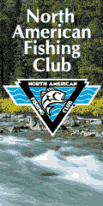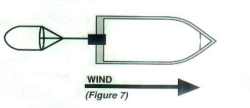
Free 90 day Risk free trial offer click
here





















|
Tail Dancing the Tailrace
By Sam Anderson
Living in Minnesota and not to far away from the Mississippi River,
allows me the opportunity to get out to a very productive area that holds
walleyes in a short period of time. The area below the dams on the
river are called tailrace areas. These are areas that most fisherman
inhabit during the winter months when ice locks up many lakes and the walleye
season is closed. This area is productive all year round and the
summer time is a great time, because it is not crowded, and the fish are
still below these man made structures. This is the time of the year that
summer river walleyes are in their prime. The walleyes like this area because
the "hole" below the dam is a resting place and a feeding area. This
area is high in oxygen and fish migrate to this area to rest and to lay
in ambush for an easy meal in current situations.
A river walleye unlike lake walleyes have to fight current all of their
lives. Therefore, the walleyes in the rivers have adapted to be in
areas that offer current breaks so they don’t have to fight the current
all of the time. These current breaks are anything that diverts the
current and allows slack water. The slack water areas are found below
the dams where an eddy is formed by the water being drawn over the dam
and rushing downstream causing a slack water area on each side of the dam.
Other obstructions that cause slack water might be below wingdams, behind
rocks, a depression in the floor of the river, a stump or fallen tree,
or man made obstacles such as bridge abutments.
The key to locating walleyes in the river starts with locating a series
of obstacles and then allowing your bait or lure to present itself in a
natural manner so the walleye can race from behind the obstruction to acquire
the offering and then race back into the slack water area to digest his
meal and await another
Look for breaks in the current. They may be behind islands, points,
and below bars in mid channel. In strong current, walleyes group
tight to structure. In softer current or low water periods, like
late summer, they often scatter, and hold on edges of barriers or current
breaks. Other spots may be structure like gravel or sandbars, shallow
rocky shoals near drop-offs, wave-washed points, deserted sandy bottom
beaches, or bottlenecks between two different landmasses. Riprap
is also good, particularly where current hits the rock; such as on a windy
point with deep-water access, or near a culvert where fresh water is filtering
through a rock causeway. Feeder streams funneling into a river represent
yet other spots which fisherman should check out. The mouths of these
tributaries often turn into fishing gold mines, especially after a heavy
rain washes fresh food and fresh water into the river. Depending
on the force of the current and the water clarity, fish may be as shallow
as a couple feet deep, or in the bottom of a washout hole, or river channel
15 to 20 feet deep. If the current is stronger than normal,
the fish probably are hunkered in a slack water area. All anglers
must learn that "current" sets the rules for location and
presentation when fishing rivers.
 Taildancer
Taildancer
|
If the walleyes are concentrated at the dam I will fish them with a
new lure called a Taildancer.
This new Tail Dancer is the first full figured, "banana styled" balsa lure
from Rapala. It is Rapala’s first balsa lure with an internal rattle,
making the Tail Dancer ideal for almost any casting or trolling application. |
This new lure is unlike anything Rapala has created before. The swimming
action is unique and the tail motion so pronounced, fish literally attack
this lure. It comes in the # 7 and # 9 size, and colors such as the
Redtail Chub and the Emerald Shiner are true to life in appearance. Selection
of a crankbait is not difficult to determine, if you keep just six factors
in mind. Choose your crankbait according to shape, size, running
depth, action, color and sound. These six factors will increase your
success while fishing this summer. Usually the tailrace areas are not crowded
with boats in the summer months, but you might start moving downstream
to holding areas. Flooded timber can be good at times.

MotorGuide
Tour Edition |
Try casting a Tail Dancer into pockets in the cover. Use
your MotorGuide
Tour Edition bowmount electric trolling motor. The trolling motor
is quiet and usually in stained water you can stand right over the top
of the fish without spooking them. Another structural element that I key
on, are the wingdams. In most of the pools on the Mississippi there
are several wingdams either near the tailwater area or down river from
the dam. When fishing a wingdam, I concentrate on the up current
side of each wingdam or the flats between them. An angler should
look for the boil line (disturbed water on the surface) that signifies
the presence of a wingdam and check out the scour hole behind the wingdam
to see if it is large enough to hold iinactive fish. |
Wingdams hold fish all year long but I like to fish them in the early summer.
Fish are unusually spooky along wingdams and noisy gas engines will
spook the fish. I prefer to use my bow mount MotorGuide electric
motor,
because it is quiet. The key element here is, to keep the
bait in front of the fish. Point the bow into the current and
"slip" down at about current speed. Keep baits in the strike zone
longer by sweeping the baits across the structure allowing the bait to
fall at a slow rate, naturally presenting the bait to the fish.
 |
Use with you bow mounted electric trolling motor by tying to the stern
of the boat. This adds more precise boat control and allows you to
follow the contour of the shoreline or hold on structure |
I t is essential; to slow down your drift with the Drift
Control sea anchor as you go over the structure and watch your depth
finder for "breaks and barriers". You might have to run your big
motor or a kicker motor in reverse to slow the presentation down even more
if the current is increased. If the fish are shallow, you might want
to anchor and use your bow mount motor to swing your bait and change your
position on the face of the wingdam. This summer if you live near a dam
or plan a vacation to an area that has a dam try some Tail Dancing and
you will see that the tailrace part of any river is very productive.
Let me know how you did and drop me a line at www.samanderson.com.

Walleyes Inc. website is maintained
by Randy
Tyler Fishing the In-Fisherman Professional Walleye Circuit, Masters
Walleye Circuit and the Team Walleye Circuit. All rights reserved.Copyright
1999/2001
Please visit these site sponsors
Daiichi/Tru-Turn Hooks,
Lindy
Little Joe,
R-A.M Mounting Systems,
Ranger
boats, Mercury Marine, Bedford
Sales , Hamby's Beaching Bumpers,
Goldeneye
Marine products, Panther
Marine Products, Webfoots body
sock, Bait Rigs Tackle
|





